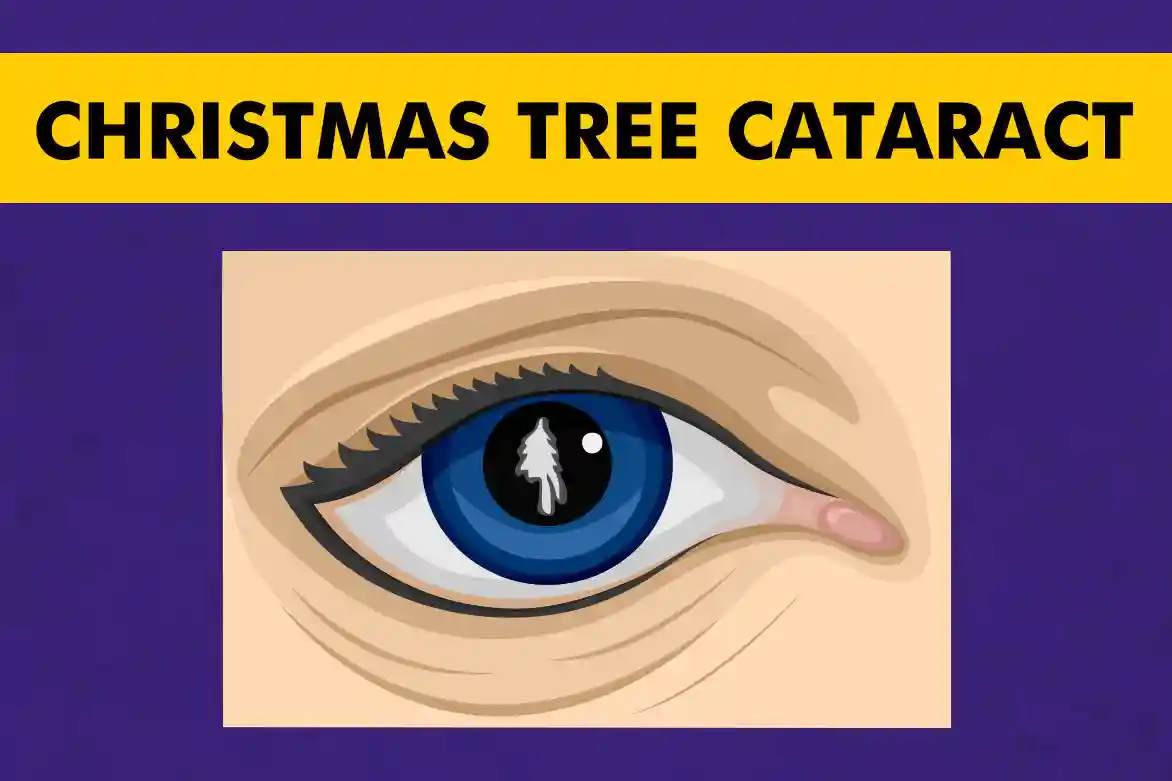Christmas tree cataract is a rare but visually striking type of age-related cataract characterized by iridescent, needle-like crystalline deposits in the lens. These deposits reflect light in a way that resembles the sparkling decorations of a Christmas tree, hence its name. While often asymptomatic in the early stages, this cataract can gradually contribute to vision impairment. Understanding its causes, symptoms, and treatment options can help in early diagnosis and effective management.
What is a Christmas Tree Cataract?
A Christmas tree cataract is a specific type of cataract that develops due to the accumulation of crystallized proteins and cholesterol deposits in the lens fibers. These opacities are known for their distinct multicolored, shimmering appearance, often in hues of red, green, blue, and gold. This cataract is usually associated with metabolic disorders and aging, appearing predominantly in older adults.
Read more about the other types of cataracts.
Causes of Christmas Tree Cataracts
The exact causes of Christmas tree cataract are not fully understood, but several factors contribute to its development:
- Aging: As the lens proteins degrade over time, structural changes may lead to crystalline deposits.
- Metabolic Disorders: Conditions like myotonic dystrophy are strongly linked to Christmas tree cataracts.
- Cholesterol and Lipid Accumulation: Increased lipid levels can contribute to crystalline formation in the lens.
- Oxidative Stress: Prolonged exposure to oxidative damage may contribute to protein crystallization.
Christmas Tree Cataract Seen In Which Cases?
Christmas tree cataract is primarily seen in:
- Older Adults: It is more common in individuals over 60 years of age.
- Myotonic Dystrophy Patients: This genetic disorder is one of the strongest associations with Christmas tree cataracts.
- Individuals with Metabolic Conditions: Those with high cholesterol or other metabolic syndromes may be more prone.
Christmas Tree Cataract Symptoms
Initially, Christmas tree cataracts may not cause noticeable symptoms. However, as it progresses, individuals may experience:
- Blurred or cloudy vision
- Difficulty seeing in dim light
- Increased sensitivity to glare and bright lights
- Reduced contrast sensitivity
- Color perception distortions
- Halos around lights, especially at night
How is Christmas Tree Cataract Diagnosed?
Christmas tree cataract is diagnosed through a combination of clinical examinations, including:
- Slit-lamp Examination: A specialized microscope helps detect the iridescent crystalline deposits.
- Visual Acuity Test: Determines the extent of vision impairment.
- Dilated Eye Examination: Provides a detailed view of the lens and retina.
- Refraction Test: Helps assess the changes in vision clarity caused by the cataract.
Potential Impact on Vision
Although Christmas tree cataract does not always lead to severe vision impairment, its progression may result in:
- Gradual vision deterioration
- Difficulty performing daily tasks such as reading and driving
- Increased dependency on bright lighting for clarity
- Greater risk of falls or accidents due to reduced visibility
Progression and Complications
If left unmonitored, Christmas tree cataracts can worsen, leading to:
- Complete Lens Opacity: Causing severe vision loss.
- Increased Risk of Other Eye Conditions: Including glaucoma or retinal disorders.
- Compromised Quality of Life: Due to reduced independence and difficulty with everyday tasks.
Management and Treatment Options
Treatment depends on the severity of the cataract:
- Observation and Regular Monitoring: If symptoms are mild, periodic eye exams can track changes.
- Corrective Lenses: Glasses or contact lenses can help compensate for minor vision loss.
- Cataract Surgery: If vision impairment becomes significant, surgical removal of the cloudy lens and replacement with an intraocular lens (IOL) is the recommended solution.
Lifestyle Modifications and Home Care
To manage symptoms and slow progression, individuals can adopt lifestyle changes such as:
- Optimizing Lighting Conditions: Using brighter lights for reading or working.
- Using Anti-Glare Lenses: Reduces glare sensitivity, especially while driving at night.
- Adopting a Healthy Diet: Consuming foods rich in antioxidants, vitamins C and E, and omega-3 fatty acids.
- Managing Underlying Health Conditions: Regularly monitoring and controlling metabolic disorders.
Preventive Measures and Eye Health
Although Christmas tree cataracts cannot always be prevented, the following measures may help maintain eye health:
- Regular Eye Check-ups: Early detection can slow progression.
- Protecting Eyes from UV Exposure: Wearing sunglasses with UV protection can reduce oxidative stress on the lens.
- Maintaining a Healthy Lifestyle: A balanced diet, regular exercise, and avoiding smoking support long-term eye health.
- Hydration and Proper Nutrition: Ensuring adequate hydration and proper nutrient intake aids overall eye function.
Conclusion
Christmas tree cataracts is a distinct but uncommon type of cataracts primarily seen in older adults and those with myotonic dystrophy. While it does not always cause severe visual impairment, regular monitoring and proper eye care are crucial. If the cataract begins to interfere with daily activities, consulting an eye specialist for potential treatment options, including surgery, is recommended.
Don’t Let Cataracts Blur Your Life Consult an Eye Specialist!
Frequently Asked Questions
What is the Christmas tree cataract associated with?
It’s associated with myotonic dystrophy, a genetic disorder affecting muscle function.
What is the rarest cataract?
Christmas tree cataract is among the rarest types.
Why are they called Christmas tree cataracts?
They’re named due to their appearance resembling the branches of a Christmas tree.
What causes Christmas tree cataracts?
They’re caused by abnormal protein deposits in the eye lens.
What are the symptoms of Christmas tree cataract?
Symptoms include blurred vision, glare sensitivity, and decreased night vision.
Are there any non-surgical treatment options available for Christmas Tree Cataract?
No, there are no non-surgical treatments; surgery is the only option.
Get more insights by reading this blog on Can you get rid of cataracts without surgery?
How long does it typically take for Christmas Tree Cataract to progress?
Progression varies but tends to be slow over years.
What are the potential side effects of cataract surgery for Christmas Tree Cataract?
Potential side effects include infection, inflammation, and increased eye pressure.
Are there any dietary supplements that can support eye health and potentially prevent Christmas Tree Cataract?
Antioxidant-rich supplements like vitamins C and E may support eye health, but they won’t prevent Christmas tree cataract.
How often should individuals with Christmas Tree Cataract undergo eye examinations?
Regular yearly eye exams are recommended.
Are there any specific precautions individuals with Christmas Tree Cataract should take to protect their eyes?
rotect eyes from UV rays, wear sunglasses, and avoid smoking.
Read blog on UV light role in cataract formation
Is Christmas Tree Cataract hereditary?
Yes, it’s associated with a genetic disorder, so there’s a hereditary component.
Can children develop Christmas Tree Cataract, and if so, how is it treated differently from adults?
Yes, children can develop it. Treatment may involve pediatric ophthalmologists and special considerations for their smaller eyes during surgery.
What causes Christmas tree cataracts?
Christmas tree cataract is caused by protein crystallization in the lens, often associated with ageing and myotonic dystrophy.
How is Christmas tree cataract seen in an eye examination?
It is identified through a slit-lamp examination, revealing bright, iridescent needle-like deposits.
What are the symptoms of Christmas tree cataracts?
Symptoms include blurred vision, glare sensitivity, color distortion, and difficulty with night vision.
Is surgery necessary for Christmas tree cataracts?
Surgery is only needed if the cataract significantly impairs vision and affects daily activities.
Can Christmas tree cataracts be prevented?
While prevention is not always possible, maintaining eye health through diet, UV protection, and regular check-ups can help delay its onset.





